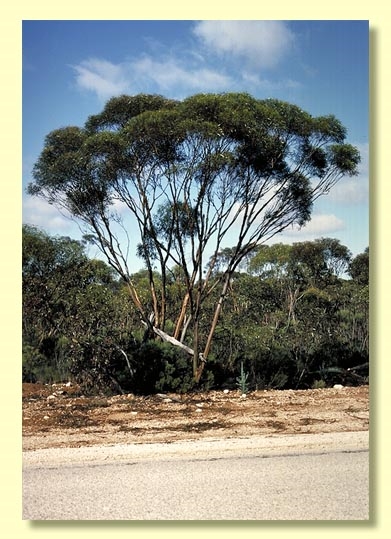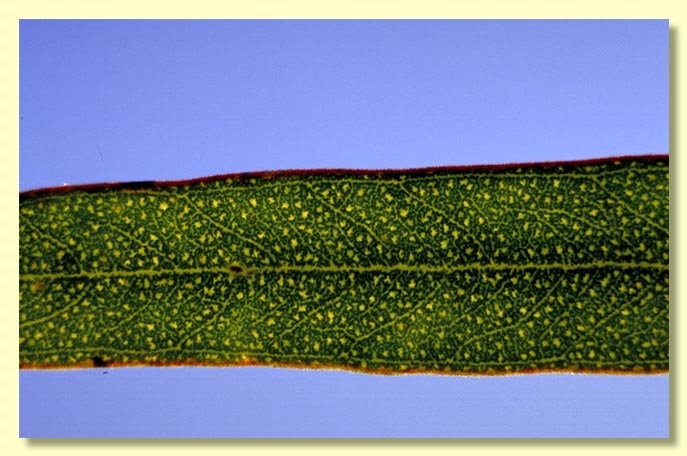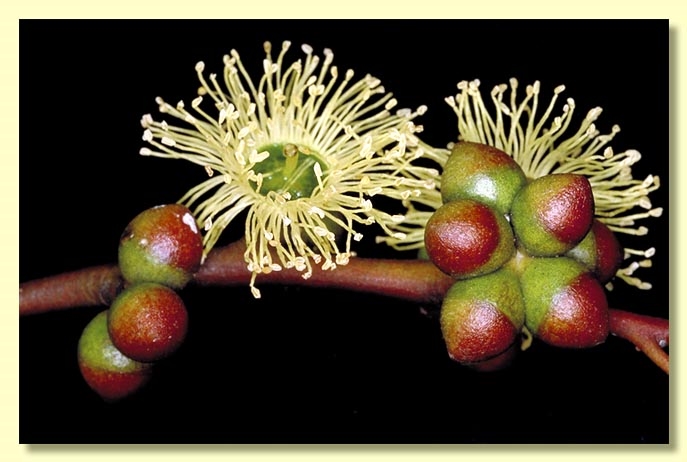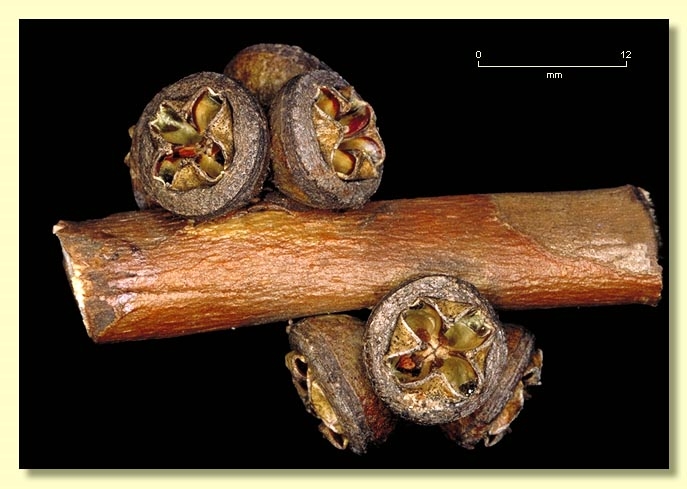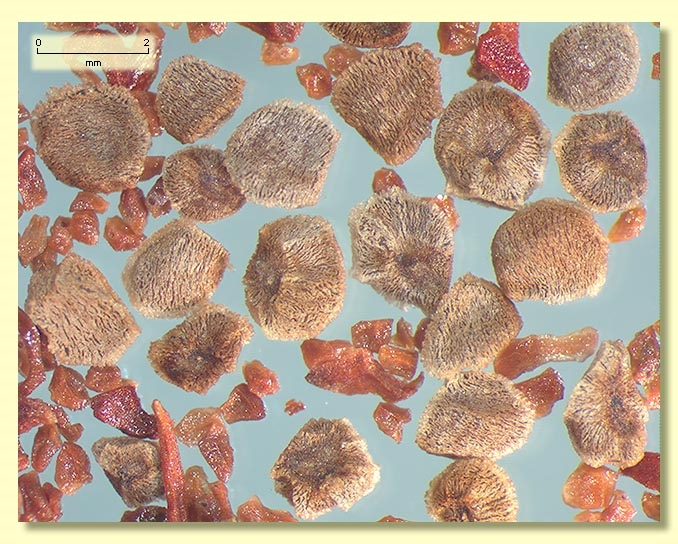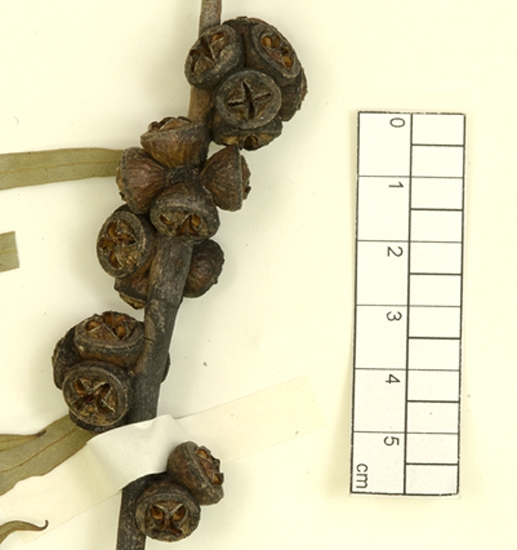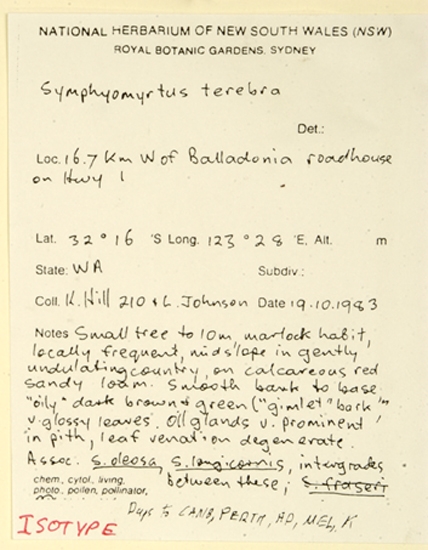Eucalyptus | Symphyomyrtus | Bisectae | Glandulosae | Contortae
Euclid - Online edition
Eucalyptus terebra
T: Western Australia: 16.7 km W of Balladonia Roadhouse along Highway 1 (32°16'S, 123°28'E), 19 Oct. 1983, K.Hill 210 & L.Johnson; holo: NSW; iso: CANB, K, MEL, PERTH.
Bark satiny or glossy, dark grey to orange, green-brown or yellowy green.
Branchlets have oil glands in the pith.
Juvenile growth (coppice or field seedlings to 50 cm): not seen.
Adult leaves alternate, petioles 0.5–1.3 cm long; blade linear to narrowly lanceolate, 6–9.5 cm long, 0.5–1.2 cm wide, base tapering to petiole, margin entire, apex pointed, glossy, green, side-veins at an acute or wider angle to midrib, reticulation sparse to moderate and broken, intramarginal vein close to margin, oil glands very irregular, island.
Inflorescence axillary unbranched, peduncles short and stout, 0.1–0.4 cm long, buds 7, sessile or pedicels to 0.2 cm long. Mature buds ovoid to globular (0.6–1 cm long, 0.6–0.8 cm wide), scar present, operculum usually rounded and apiculate, stamens inflexed, anthers oblong, versatile, sub-basifixed, dehiscing by longitudinal slits, style long and straight, stigma blunt, locules 4(5), the placentae each with 6 to 8 vertical rows of ovules. Flowers lemon-yellow to greenish yellow.
Fruit sessile, broadly and shallowly obconical to hemispherical, 0.3–0.6 cm long, 0.9–1.3 cm wide, disc level, valves 4(5), exserted.
Seeds pale to mid-brown, 1–2 mm long, ovoid to flattened-ovoid or polygonal in outline, dorsal surface deeply, narrowly and closely fissured, margin toothed, hilum ventral. (Seedcoat often referred to as being honey-combed.)
Cultivated seedlings (measured at ca node 10): cotyledons Y-shaped (bisected); stems rounded in cross-section, smooth; leaves always petiolate, opposite for 3 or 4 nodes then alternate, lanceolate, 5–9 cm long, 1–2 cm wide, dull, green.
Flowering has been recorded in August and November.
A mallet endemic to Western Australia, restricted to the area between Norseman and Balladonia and south towards Mt Ney. The trunk or stems are smooth, satiny, usually coloured yellowish, greenish or coppery. The adult leaves are glossy green and buds are in sevens.
Eucalyptus terebra belongs in Eucalyptus subgenus Symphyomyrtus section Bisectae subsection Glandulosae because the buds have two opercula, the cotyledons are bisected and the branchlets have numerous oil glands in the pith.
Within this subgroup Eucalyptus terebra belongs to a small well known group, the gimlets (series Contortae), notable for the slender fluted, twisted shiny colourful trunks. The gimlets are further recognised by very irregularly shaped island oil glands in the leaves and irregularly and deeply fissured seed-coats.
There are six species of gimlet with buds in clusters of seven (E. campaspe, E. effusa, E. ravida, E. salubris, E. terebra, E. tortilis). E. terebra is easily distinguished from all the others because it has large, sessile, crowded, sub-globular, apiculate buds and crowded, broadly and shallowly hemispherical fruit. It is also a broad-crowned stout tree rather than being slender, erect and graceful.
At the base of Jimberlana Hill near Norseman there is a population of gimlets with morphology somewhat intermediate between E. terebra and E. ravida. The name Eucalyptus jimberlanica was applied to these in 1991, but it is not recognised in EUCLID as we are not convinced it is a distinct species but possibly a hybrid.

